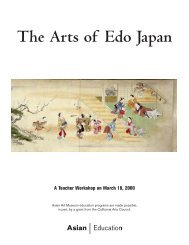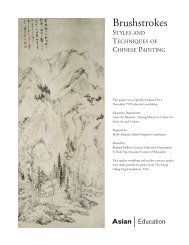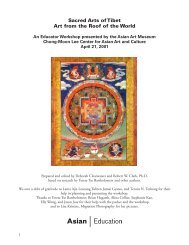Download PDF (free) - Asian Art Museum | Education
Download PDF (free) - Asian Art Museum | Education
Download PDF (free) - Asian Art Museum | Education
Create successful ePaper yourself
Turn your PDF publications into a flip-book with our unique Google optimized e-Paper software.
Katsushika Hokusai (1760-1849)<br />
Hokusai was born on October 31, 1760, in Honjo, Edo, of unknown parentage.<br />
While Hokusai moved at least ninety times throughout his lifetime, he never left this<br />
region. He was adopted as a child by the prestigious artisan-family Nakajima Ise,<br />
who made mirrors for the shogun. He possibly might have been a son of Ise by his<br />
mistress.<br />
As a teenager, Hokusai was a delivery boy for a booklending shop and also<br />
apprenticed to a woodblock carver. At the age of eighteen, Hokusai began serious<br />
training in print design under Katsukawa Shunsho (1726-1792), an eminent designer<br />
in Kabuki actor and theater prints. Under the name Shunsho, Hokusai illustrated<br />
storybooks and created prints depicting beautiful women. After his teacher’s death in<br />
1793, Hokusai entered a period of wandering, searching restlessly for different styles<br />
and themes in association with artists outside the Katsukawa School.<br />
An eccentric artist, Hokusai changed his artistic name at least twenty times. In 1797,<br />
the artist began using the name Hokusai, the best known to us. Frequently, he<br />
combined it with others, creating a variety of names, such as Sori arateme Hokusai<br />
(“Hokusai changed from Sori”), Hokusai Sori, or Gakyojin Hokusai (“A Man Mad<br />
about <strong>Art</strong>, Hokusai”).<br />
Around 1804, Hokusai studied Western styles based on Dutch copperplate prints.<br />
In his new work influenced by the Dutch prints, Hokusai gave an illusion of<br />
space and landscape elements using light and dark shadows and signed his name<br />
horizontally in imitation of Western artists.<br />
Between 1811-1830, Hokusai published an enormous number of illustrated books.<br />
The most important was Hokusai Manga (“Hokusai’s Random Sketches”), the<br />
artist’s lifelong project, which took thirty-eight years. Only two volumes were<br />
published at this time.<br />
The year 1831 marked the beginning of Hokusai’s most productive period while he<br />
was in his seventies. He published his monumental landscape series, Thirty-six View<br />
of Mount Fuji. Although the title indicates thirty-six, forty-six prints were made.<br />
Because of their popularity, the publisher added ten prints to the series. The series<br />
probably took a few years to complete.<br />
Between 1833-34, three other major series were published: A Tour of Japanese<br />
Waterfalls, Imagery of the Poets, and Rare Views of Famous Bridges in All Provinces.<br />
Another important publication was One Hundred Views of Mount Fuji. From 1836<br />
to 1845, Hokusai diligently worked on book illustrations and various commissioned<br />
works.<br />
Hokusai was a good teacher, producing 111 students of the Katsushika School. He<br />
was a disciplined worker who rose early in the morning, painting and drawing until<br />
evening. Despite his prolific work and relative fame, Hokusai constantly battled<br />
poverty. Unlike masters of the prestigious painting schools, ukiyo-e artists were<br />
poorly paid. Hokusai’s frequent name changes may have resulted from the need to<br />
sell his old names to his students, a common practice among artists. His multiple<br />
changes in residence could also have been due to poverty. Hokusai died on May 10,<br />
<strong>Asian</strong> <strong>Art</strong> <strong>Museum</strong> 12
















